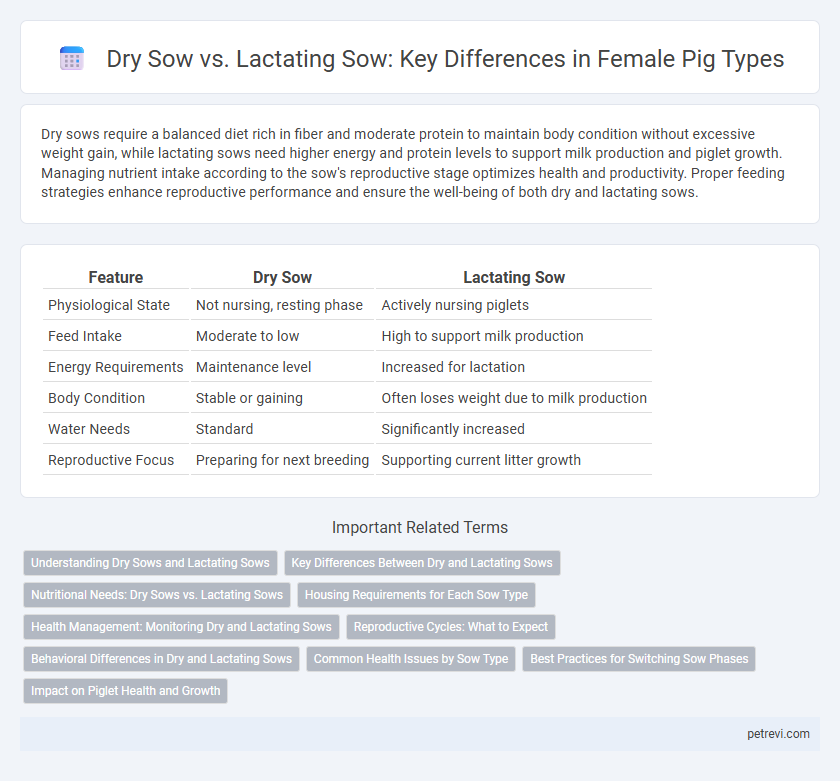Dry sows require a balanced diet rich in fiber and moderate protein to maintain body condition without excessive weight gain, while lactating sows need higher energy and protein levels to support milk production and piglet growth. Managing nutrient intake according to the sow's reproductive stage optimizes health and productivity. Proper feeding strategies enhance reproductive performance and ensure the well-being of both dry and lactating sows.
Table of Comparison
| Feature | Dry Sow | Lactating Sow |
|---|---|---|
| Physiological State | Not nursing, resting phase | Actively nursing piglets |
| Feed Intake | Moderate to low | High to support milk production |
| Energy Requirements | Maintenance level | Increased for lactation |
| Body Condition | Stable or gaining | Often loses weight due to milk production |
| Water Needs | Standard | Significantly increased |
| Reproductive Focus | Preparing for next breeding | Supporting current litter growth |
Understanding Dry Sows and Lactating Sows
Dry sows are female pigs in the non-lactating phase, typically after weaning and before the next farrowing, focusing on body condition recovery and nutrient replenishment. Lactating sows produce milk for their piglets, requiring higher energy and protein intake to support milk production and maintain health. Proper management of feed, environment, and health is critical for both dry and lactating sows to optimize reproductive performance and piglet growth.
Key Differences Between Dry and Lactating Sows
Dry sows require a diet optimized for maintenance and body condition, typically lower in energy and protein, while lactating sows need nutrient-dense feed rich in energy, protein, vitamins, and minerals to support milk production. Water intake is critical for lactating sows, often doubling compared to dry sows, to sustain lactation demands. Additionally, dry sows experience reduced physiological stress and nutrient requirements, whereas lactating sows demand increased caloric intake and meticulous management to prevent body condition loss.
Nutritional Needs: Dry Sows vs. Lactating Sows
Dry sows require a balanced diet with moderate energy and fiber to maintain body condition during gestation, emphasizing adequate protein and minerals for fetal development. Lactating sows demand significantly higher energy, protein, and water intake to support milk production and the growth of piglets, often resulting in increased feed intake by 50-70% compared to dry sows. Nutritional management must adjust to these physiological stages to optimize reproductive performance and piglet health.
Housing Requirements for Each Sow Type
Dry sows require individual or group housing with adequate space of at least 18 square feet per animal, good ventilation, and non-slip flooring to support comfort and health during gestation. Lactating sows need farrowing crates or pens that provide a warm, draft-free environment with constant access to clean water, approximately 24 square feet per sow, and proper bedding to ensure piglet safety and ease of nursing. Both housing types must facilitate easy feeding, waste removal, and monitoring to optimize sow welfare and productivity.
Health Management: Monitoring Dry and Lactating Sows
Monitoring dry and lactating sows requires distinct health management strategies due to their varying nutritional and physiological needs. Dry sows need balanced diets to maintain body condition and prevent metabolic disorders, while lactating sows require higher energy and nutrient intake to support milk production and piglet growth. Effective health monitoring includes regular body condition scoring, hydration checks, and observation for signs of mastitis or reproductive tract infections in both sow types.
Reproductive Cycles: What to Expect
Dry sows experience a non-lactating period where their reproductive cycle includes estrus and gestation phases, typically lasting around 114 days from conception to farrowing. Lactating sows undergo a suppression of estrus during lactation, with hormonal changes delaying the return to heat until after weaning, which commonly occurs at 3 to 5 weeks postpartum. Understanding these distinct reproductive cycles aids in optimizing breeding schedules and improving overall herd fertility management.
Behavioral Differences in Dry and Lactating Sows
Dry sows exhibit increased restlessness and feed-seeking behavior as they prepare for farrowing, often showing reduced aggression within the group. Lactating sows demonstrate heightened maternal instincts, including frequent nursing postures and protective behaviors toward piglets, accompanied by decreased mobility to conserve energy for milk production. Social interactions shift from dominance displays in dry sows to nurturing and vigilance in lactating sows, reflecting their distinct physiological and behavioral states.
Common Health Issues by Sow Type
Dry sows commonly face health issues such as lameness and uterine infections due to prolonged inactivity and breeding stress. Lactating sows are prone to mastitis and shoulder ulcers, resulting from high milk production demands and reduced mobility. Managing nutrition and hygiene tailored to each sow type is essential to prevent these condition-specific ailments and maintain overall sow health.
Best Practices for Switching Sow Phases
Switching from dry sow to lactating sow phases requires adjusting nutrition to support increased energy and protein needs during lactation. Emphasizing high-fiber diets for dry sows promotes gut health and reproductive efficiency, while lactating sows benefit from nutrient-dense, easily digestible feed to sustain milk production. Monitoring body condition score closely during transitions prevents excessive weight loss and optimizes piglet growth and sow reproductive performance.
Impact on Piglet Health and Growth
Dry sows experience lower nutritional demands compared to lactating sows, which directly influences piglet health and growth during the nursing period. Lactating sows require increased energy and nutrient intake to support milk production, ensuring piglets receive adequate nutrients for optimal weight gain and immune development. Proper management of sow diet and health during lactation is critical to enhancing piglet survival rates and growth performance.
Dry Sow vs Lactating Sow for Pig Female Type Infographic

 petrevi.com
petrevi.com